|
Previous Page
Emerson, Lake and Palmer - "Emerson, Lake and Palmer" (Island 1970)
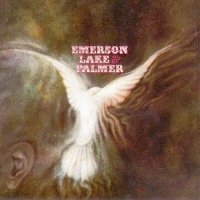 Keith Emerson from The Nice, Greg Lake from King Crimson and Carl Palmer from Atomic Rooster. ELP was not just rock's first supergroup, the were also the best progressive rock trio ever and their sound would become the blueprint for almost any keyboard-based progressive rock group. Their debut-album remains one of the best progressive rock debuts, and few other bands would find their signature-sound quicker than ELP. The album featured all the elements of classic ELP: Emerson's extremely powerful organ and innovative use of the moog, Lake's beautiful voice and sense for good melodies and not at least Palmer's furious and technically perfect drumming. The opening number is a version of Bartok's "The Barbarian" that almost borders on heavy-progressive. Very aggressive and noisy, and the whole band plays like it should be the last thing they ever did in their life. This track kicks the ass off...well, almost everything. The contrast to "Take a Pebble" is big, and stands as one of ELP's best ballads and undoubtedly the most progressive one with its 12 minutes. The vocal-melody is pure beauty, and the instrumental sections are atmospheric and pleasant. But the band returns to the loud and powerful style again in "Knife-Edge" that is partly based in a piece by Janacek. "The Three Fates" is an instrumental number divided into three parts. The first part is played on church-organ while "Lachesis" is a beautiful piano-piece. The last part is an energetic and chaotic passage reminiscent of the riffs from "Tarkus" but played on piano instead of organ. "Tank" is an excellent showcase for Palmer's drumming and it's also the only ELP-track I'm aware of where Emerson is using the clavinet. The closing-number "Lucky Man" is Lake's most famous acoustic song, and it features a revolutionary moog-solo from Emerson at the end. "Emerson, Lake and Palmer" has also the advantage of being the only classic ELP-album without any of the idiotic "we're-usually-very-serious-but-we-can-be-really-funny-too!"-ditties ("Jeremy Bender", "Are You Ready Eddie?" and "Benny the Bouncer") that were on most of their other albums. Keith Emerson from The Nice, Greg Lake from King Crimson and Carl Palmer from Atomic Rooster. ELP was not just rock's first supergroup, the were also the best progressive rock trio ever and their sound would become the blueprint for almost any keyboard-based progressive rock group. Their debut-album remains one of the best progressive rock debuts, and few other bands would find their signature-sound quicker than ELP. The album featured all the elements of classic ELP: Emerson's extremely powerful organ and innovative use of the moog, Lake's beautiful voice and sense for good melodies and not at least Palmer's furious and technically perfect drumming. The opening number is a version of Bartok's "The Barbarian" that almost borders on heavy-progressive. Very aggressive and noisy, and the whole band plays like it should be the last thing they ever did in their life. This track kicks the ass off...well, almost everything. The contrast to "Take a Pebble" is big, and stands as one of ELP's best ballads and undoubtedly the most progressive one with its 12 minutes. The vocal-melody is pure beauty, and the instrumental sections are atmospheric and pleasant. But the band returns to the loud and powerful style again in "Knife-Edge" that is partly based in a piece by Janacek. "The Three Fates" is an instrumental number divided into three parts. The first part is played on church-organ while "Lachesis" is a beautiful piano-piece. The last part is an energetic and chaotic passage reminiscent of the riffs from "Tarkus" but played on piano instead of organ. "Tank" is an excellent showcase for Palmer's drumming and it's also the only ELP-track I'm aware of where Emerson is using the clavinet. The closing-number "Lucky Man" is Lake's most famous acoustic song, and it features a revolutionary moog-solo from Emerson at the end. "Emerson, Lake and Palmer" has also the advantage of being the only classic ELP-album without any of the idiotic "we're-usually-very-serious-but-we-can-be-really-funny-too!"-ditties ("Jeremy Bender", "Are You Ready Eddie?" and "Benny the Bouncer") that were on most of their other albums.
Emerson, Lake and Palmer - "Tarkus" (Island 1971)
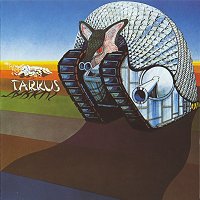 There are several reasons for why Emerson, Lake and Palmer's second album perhaps was the most important release for their entire career. Not only because it had to follow up the debut in a convincing way, but also because they had to prove that there was still a lot more left after the "supergroup" hype was gone. I think you safely can say that they succeeded as well as they possibly could, as "Tarkus" turned out to be not just one of the seminal albums of keyboard-based progressive rock, but one of the milestones and icons of progressive rock in general. The 20-minute multi-part title-track is among the five best progressive rock compositions of all time, as well as featuring some of the most technically demanding and accomplished playing caught on vinyl. The lyrics told the story about Tarkus (the heavily armed armadillo on the cover) who goes on and kills one enemy after another (all of them are half machine/half animal creatures like himself) before he is defeated by the Manticore. The suite kicks off with the fantastic instrumental opening fanfare of "Eruption" where the fast and complicated rhythms are layered with Emerson's organ and piano, and serves as one of the main foundations for much of the track, although it changes nearly all the time during its 20-minute course. Lake's vocals make its first appearance during "Stones of Years" that also features one of Emerson's best organ solos, where the beautiful, glassy, crystal-clear and very clicky Hammond sound that he uses on the whole track really shines. The rhythms from "Eruption" makes a short return in a more disharmonic form in the instrumental interlude "Iconoclast" and introduces the Moog-driven vocal track "Mass" where Emerson's quirky solo-section includes some of the most ballsy Hammond sound you'll ever hear. "Manticore" is definitively the heaviest, most aggressive and dramatic part of the entire track, but is followed by the mighty "Battlefield" that on the other hand stands as the most beautiful part in the suite, with a gorgeous melodic theme. This theme is also taken over into the closing section "Aqautarkus" before the whole thing returns to the opening theme again and makes one hell of a powerful finale to one of progressive rock's main tracks. The band calms down a bit for the slightly more modest second side of the album; although tracks like the fast paced "Bitches Crystal" and the powerful and aggressive "A Time and a Place" sure both have their share of energy. The whimsical and lightweight "Jeremy Bender" and the basic traditional rock'n'roll of "Are You Ready Eddy?" will surely not please everyone, but they are fortunately kept short and the trio doesn't seem to hide the fact that both probably just were done for fun in the studio. Way more serious is "The Only Way", based around a heavenly melody sung by Lake over Emerson's grandiose church-organ, and leads the way into the piano-based instrumental "Infinite Space". Along with "Fragile" and "Nursery Cryme", "Tarkus" is undoubtedly the best and most important progressive rock album from 1971. There are several reasons for why Emerson, Lake and Palmer's second album perhaps was the most important release for their entire career. Not only because it had to follow up the debut in a convincing way, but also because they had to prove that there was still a lot more left after the "supergroup" hype was gone. I think you safely can say that they succeeded as well as they possibly could, as "Tarkus" turned out to be not just one of the seminal albums of keyboard-based progressive rock, but one of the milestones and icons of progressive rock in general. The 20-minute multi-part title-track is among the five best progressive rock compositions of all time, as well as featuring some of the most technically demanding and accomplished playing caught on vinyl. The lyrics told the story about Tarkus (the heavily armed armadillo on the cover) who goes on and kills one enemy after another (all of them are half machine/half animal creatures like himself) before he is defeated by the Manticore. The suite kicks off with the fantastic instrumental opening fanfare of "Eruption" where the fast and complicated rhythms are layered with Emerson's organ and piano, and serves as one of the main foundations for much of the track, although it changes nearly all the time during its 20-minute course. Lake's vocals make its first appearance during "Stones of Years" that also features one of Emerson's best organ solos, where the beautiful, glassy, crystal-clear and very clicky Hammond sound that he uses on the whole track really shines. The rhythms from "Eruption" makes a short return in a more disharmonic form in the instrumental interlude "Iconoclast" and introduces the Moog-driven vocal track "Mass" where Emerson's quirky solo-section includes some of the most ballsy Hammond sound you'll ever hear. "Manticore" is definitively the heaviest, most aggressive and dramatic part of the entire track, but is followed by the mighty "Battlefield" that on the other hand stands as the most beautiful part in the suite, with a gorgeous melodic theme. This theme is also taken over into the closing section "Aqautarkus" before the whole thing returns to the opening theme again and makes one hell of a powerful finale to one of progressive rock's main tracks. The band calms down a bit for the slightly more modest second side of the album; although tracks like the fast paced "Bitches Crystal" and the powerful and aggressive "A Time and a Place" sure both have their share of energy. The whimsical and lightweight "Jeremy Bender" and the basic traditional rock'n'roll of "Are You Ready Eddy?" will surely not please everyone, but they are fortunately kept short and the trio doesn't seem to hide the fact that both probably just were done for fun in the studio. Way more serious is "The Only Way", based around a heavenly melody sung by Lake over Emerson's grandiose church-organ, and leads the way into the piano-based instrumental "Infinite Space". Along with "Fragile" and "Nursery Cryme", "Tarkus" is undoubtedly the best and most important progressive rock album from 1971.
Label
Emerson, Lake and Palmer - "Pictures at an Exhibition" (Island 1971)
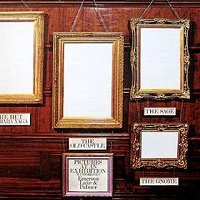 ELP's legendary "rape" of Mussorgsky's beautiful "Pictures at an Exhibition" remains one of the best examples of a rock version of a classical piece. The band stays true to all the original themes, but plays them with the energy, rawness and loudness of rock. They also added some self-written pieces, like Lake's "The Sage" and the energetic jam "Blues Variation". The piece was one of the band's favourites on stage, so the album was then naturally also recorded live. This is the live-album that best demonstrates what a tight and powerful unit ELP were on stage. It was also their most moog-dominated album to that point, and Emerson experiments with any sound possible on the instrument. But his organ-playing was still the main focus in the music, and especially on side 2 deliver the whole band some of their most raw and energetic playing ever. The album also featured a rather cheesy version of "Nutrocker" that was released as a single. "Pictures at an Exhibition" is probably not the best place to start with ELP, but you'll surely enjoy it a lot when you're into them. ELP's legendary "rape" of Mussorgsky's beautiful "Pictures at an Exhibition" remains one of the best examples of a rock version of a classical piece. The band stays true to all the original themes, but plays them with the energy, rawness and loudness of rock. They also added some self-written pieces, like Lake's "The Sage" and the energetic jam "Blues Variation". The piece was one of the band's favourites on stage, so the album was then naturally also recorded live. This is the live-album that best demonstrates what a tight and powerful unit ELP were on stage. It was also their most moog-dominated album to that point, and Emerson experiments with any sound possible on the instrument. But his organ-playing was still the main focus in the music, and especially on side 2 deliver the whole band some of their most raw and energetic playing ever. The album also featured a rather cheesy version of "Nutrocker" that was released as a single. "Pictures at an Exhibition" is probably not the best place to start with ELP, but you'll surely enjoy it a lot when you're into them.
Emerson, Lake and Palmer - "Trilogy" (Island 1972)
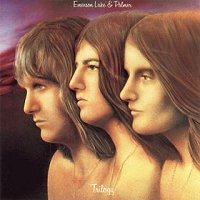 "Trilogy" was the most melodic and easy accessible of ELP's classic albums, so it's quite weird that it sold rather poorly compared to the three previous albums. The album scored a hit with Lake's acoustic "From the Beginning" but the title-track and the majestic opener "The Endless Enigma" was the true highlights of the album. Especially the latter one had one of the most beautiful melodies ELP ever wrote. And let's not forget about the ultra-catchy instrumental "Hoedown" that they would use to open their concerts. "The Sheriff" is probably the "best" of ELP's earlier mentioned attempts at making some less serious and more light-hearted stuff, although it's not exactly a milestone in their career either. "Living Sin" is a raw and rocking track, actually not all that far from Deep Purple but more complex and involving with some powerful synth-riffs from Emerson. "Abbadon's Bolero" was not the best track on the record, as it's a quite repetitive and tiresome composition that only really takes off at the end when it reaches the climax of the build-up with Emerson's moog on top. But "Trilogy" is still among ELP's best albums. "Trilogy" was the most melodic and easy accessible of ELP's classic albums, so it's quite weird that it sold rather poorly compared to the three previous albums. The album scored a hit with Lake's acoustic "From the Beginning" but the title-track and the majestic opener "The Endless Enigma" was the true highlights of the album. Especially the latter one had one of the most beautiful melodies ELP ever wrote. And let's not forget about the ultra-catchy instrumental "Hoedown" that they would use to open their concerts. "The Sheriff" is probably the "best" of ELP's earlier mentioned attempts at making some less serious and more light-hearted stuff, although it's not exactly a milestone in their career either. "Living Sin" is a raw and rocking track, actually not all that far from Deep Purple but more complex and involving with some powerful synth-riffs from Emerson. "Abbadon's Bolero" was not the best track on the record, as it's a quite repetitive and tiresome composition that only really takes off at the end when it reaches the climax of the build-up with Emerson's moog on top. But "Trilogy" is still among ELP's best albums.
Emerson, Lake and Palmer - "Brain Salad Surgery" (Manticore 1973)
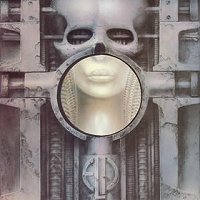 "Tarkus" is ELP's best track, but their best ALBUM is in my opinion "Brain Salad Surgery". This is just how over the top ELP could be without falling down on the other side of it like they did later. The album opens with an absolutely beautiful version of the old English hymn "Jerusalem". Hearing Lake's wonderful voice against Emerson's mighty church-organ gives me goosebumps every time. Then you're in for one of ELP's most experimental pieces ever with a version of Ginastera's "Toccata". The organ-parts are in the vein of the most aggressive parts from "Tarkus" while the synths and electronic parts is some of the weirdest and most freaked-out playing Emerson ever did. The first self-written track on the album comes in the form of Lake's magic "Still...You Turn Me On". This is easily one of his strongest songs ever. Oh, and Peter Sinfield was now the man who wrote the lyrics for the band, making sure that they delivered top-notch stuff in that department too! Unfortunately, you then have to suffer through a few minutes of 100% pure garbage in "Benny the Bouncer". Sorry, guys, you're not funny at all so you should better focusing on making good progressive rock instead of pretending to be comedians. And that was just what the boys did on the rest of the album that consisted of the 30-minute "Karn Evil 9". The piece was so long that they actually had to start it on side 1 and then continue it on the whole of side 2! Only "Tarkus" can rival this masterpiece as ELP's best composition ever. This is keyboard-based progressive rock-heaven stuffed with masterful instrumental-passages, strong riffs, themes and melodies all the way through. A stunning masterpiece in the history of progressive rock! But time would show that this was also ELP's last classic album. "Tarkus" is ELP's best track, but their best ALBUM is in my opinion "Brain Salad Surgery". This is just how over the top ELP could be without falling down on the other side of it like they did later. The album opens with an absolutely beautiful version of the old English hymn "Jerusalem". Hearing Lake's wonderful voice against Emerson's mighty church-organ gives me goosebumps every time. Then you're in for one of ELP's most experimental pieces ever with a version of Ginastera's "Toccata". The organ-parts are in the vein of the most aggressive parts from "Tarkus" while the synths and electronic parts is some of the weirdest and most freaked-out playing Emerson ever did. The first self-written track on the album comes in the form of Lake's magic "Still...You Turn Me On". This is easily one of his strongest songs ever. Oh, and Peter Sinfield was now the man who wrote the lyrics for the band, making sure that they delivered top-notch stuff in that department too! Unfortunately, you then have to suffer through a few minutes of 100% pure garbage in "Benny the Bouncer". Sorry, guys, you're not funny at all so you should better focusing on making good progressive rock instead of pretending to be comedians. And that was just what the boys did on the rest of the album that consisted of the 30-minute "Karn Evil 9". The piece was so long that they actually had to start it on side 1 and then continue it on the whole of side 2! Only "Tarkus" can rival this masterpiece as ELP's best composition ever. This is keyboard-based progressive rock-heaven stuffed with masterful instrumental-passages, strong riffs, themes and melodies all the way through. A stunning masterpiece in the history of progressive rock! But time would show that this was also ELP's last classic album.
Emerson, Lake and Palmer - "Welcome Back My Friends to the Show That Never Ends" (Manticore 1974)
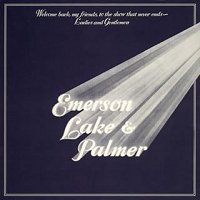 ELP finished their best and most creative years with this triple live-album. I must honestly admit that my views about this album have changed over the years. While I still think the studio-versions are better, I can't deny the musical quality and the fact that this album gives you nearly 2 hours of some of the best and most over the top progressive rock ever recorded. The band delivers an excellent performance of material from all the albums they had released until then (with the natural exception of "Pictures at an Exhibition"). The album opens with a fast and energetic version of "Hoedown" and it really proves that ELP were one of the most technical perfect and impressive groups of the 70's. The beautiful "Jerusalem" and their aggressive version of "Toccata" are also performed in a way that makes it sounds like the easiest thing in the world for the trio. Then you're in for a real treat with a monumental version of "Tarkus" that is so long that it continues on the third side of the album! And the track sounds different enough from the studio-version to make it interesting all the way through. "Take a Pebble" is performed as a long medley with lots of piano-improvisations from Emerson and also some really emotional versions of "Still...You Turn Me On" and "Lucky Man" performed by nothing else than Lake and his acoustic guitar. "Jeremy Bender" and "The Sheriff" are melted into one track and demonstrate the poppier and less serious side of the band very well. The third LP in the set is taken up in its entirety of a convincing performance of "Karn Evil 9". This album should be a real feast for anyone into keyboard-based 70's progressive rock, and it's also from the trio who actually invented that genre. ELP finished their best and most creative years with this triple live-album. I must honestly admit that my views about this album have changed over the years. While I still think the studio-versions are better, I can't deny the musical quality and the fact that this album gives you nearly 2 hours of some of the best and most over the top progressive rock ever recorded. The band delivers an excellent performance of material from all the albums they had released until then (with the natural exception of "Pictures at an Exhibition"). The album opens with a fast and energetic version of "Hoedown" and it really proves that ELP were one of the most technical perfect and impressive groups of the 70's. The beautiful "Jerusalem" and their aggressive version of "Toccata" are also performed in a way that makes it sounds like the easiest thing in the world for the trio. Then you're in for a real treat with a monumental version of "Tarkus" that is so long that it continues on the third side of the album! And the track sounds different enough from the studio-version to make it interesting all the way through. "Take a Pebble" is performed as a long medley with lots of piano-improvisations from Emerson and also some really emotional versions of "Still...You Turn Me On" and "Lucky Man" performed by nothing else than Lake and his acoustic guitar. "Jeremy Bender" and "The Sheriff" are melted into one track and demonstrate the poppier and less serious side of the band very well. The third LP in the set is taken up in its entirety of a convincing performance of "Karn Evil 9". This album should be a real feast for anyone into keyboard-based 70's progressive rock, and it's also from the trio who actually invented that genre.
Label
Emerson, Lake and Palmer - "Works" (Atlantic 1977)
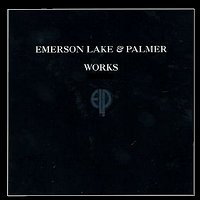 ELP did a kind of a comeback in the late 70's that everybody would have been better without. They broke the three years of silence since "Welcome Back..." with this orchestrated double-album that was a combined solo/group album where the three first sides consisted of solo-stuff from each of the three members, while the fourth and last side consisted of two tracks by the whole band. The album is an absolute bore from start to finish, and I don't think they could have delivered a better proof that their egos had grown far too big and were starting to drift apart from each other. Anyway, Emerson's side of the album consisted of a piano concerto in three movements where an orchestra backs him. There are a few decent themes and melodies to be found among all the orchestrated mess, but most of it is rather dull and forgettable. Lake's side is not surprisingly taken up by his typical soft and acoustic songs. "Lend Your Love to Me Tonight" and "C'Est La Vie" is undoubtedly the best ones, the three others are completely forgettable. "Closer to Believing" is actually rather pretty too, but too long and repetitive. Palmer's side is the worst of them all, demonstrating to the full how awfully uninteresting drummers are as solo-artists. What you get is a bunch of uninspired instrumentals that sounds like outtakes from some random jam-sessions. The fact that he also included a lame re-recording of "Tank" shows that he had no ideas to display at all. What a waste! The group-side featured two songs. First you had their version of "Fanfare for the Common Man" that became a minor hit in an edited single-version. The album-version is 10 minutes long, and features a long jam in the middle with lots of rather ugly and technological sounds from Emerson. Boring stuff. The 13-minute "Pirates" closes the album, but don't expect it to be a classic epic like ELP did in the early days. This is just boring, tasteless and forgettable. By the way, where the hell is Emerson's organ? It's actually nowhere to be found on this album! And the sound of Emerson's Hammond was even the most defining thing in the classic ELP-sound!!! Can you imagine Mike Oldfield quit using guitars on his albums? "Works" is progressive rock at its worst and most useless, so you should better avoid it and save your money. ELP did a kind of a comeback in the late 70's that everybody would have been better without. They broke the three years of silence since "Welcome Back..." with this orchestrated double-album that was a combined solo/group album where the three first sides consisted of solo-stuff from each of the three members, while the fourth and last side consisted of two tracks by the whole band. The album is an absolute bore from start to finish, and I don't think they could have delivered a better proof that their egos had grown far too big and were starting to drift apart from each other. Anyway, Emerson's side of the album consisted of a piano concerto in three movements where an orchestra backs him. There are a few decent themes and melodies to be found among all the orchestrated mess, but most of it is rather dull and forgettable. Lake's side is not surprisingly taken up by his typical soft and acoustic songs. "Lend Your Love to Me Tonight" and "C'Est La Vie" is undoubtedly the best ones, the three others are completely forgettable. "Closer to Believing" is actually rather pretty too, but too long and repetitive. Palmer's side is the worst of them all, demonstrating to the full how awfully uninteresting drummers are as solo-artists. What you get is a bunch of uninspired instrumentals that sounds like outtakes from some random jam-sessions. The fact that he also included a lame re-recording of "Tank" shows that he had no ideas to display at all. What a waste! The group-side featured two songs. First you had their version of "Fanfare for the Common Man" that became a minor hit in an edited single-version. The album-version is 10 minutes long, and features a long jam in the middle with lots of rather ugly and technological sounds from Emerson. Boring stuff. The 13-minute "Pirates" closes the album, but don't expect it to be a classic epic like ELP did in the early days. This is just boring, tasteless and forgettable. By the way, where the hell is Emerson's organ? It's actually nowhere to be found on this album! And the sound of Emerson's Hammond was even the most defining thing in the classic ELP-sound!!! Can you imagine Mike Oldfield quit using guitars on his albums? "Works" is progressive rock at its worst and most useless, so you should better avoid it and save your money.
Emerson, Lake and Palmer - "Works Vol. 2" (Atlantic 1977)
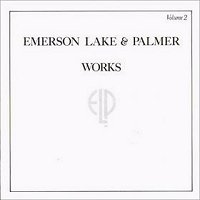 The best thing about vol. 2 compared to the first one, is that this at least is a single album and means about 40 minutes less of drivel to suffer through. The album is a completely directionless, crappy and pointless mess of outtakes, single b-sides, re-recordings of solo-singles and a couple of new tracks. The opener "Tiger in a Spotlight" was one of the new tracks and is a quite catchy and funny song, but the extremely cheesy arrangement (Emerson had obviously still lost his organ) makes it almost unbearable to listen to. And the album also offers you an opportunity to hear Lake's classic Christmas-hit "I Believe in Father Christmas". And then I've mentioned the decent stuff here. "Watching Over You" and "Show Me the Way to Go Home" are among Lake's most boring tunes ever. The worst thing here is still the awful honky-tonk and ragtime-crap that Emerson was messing around with. What the hell is this? Soundtrack to a Charles Chaplin-movie? "Shit Vol. 1 & 2" would have been a much more fitting title for both these dreadful albums. The best thing about vol. 2 compared to the first one, is that this at least is a single album and means about 40 minutes less of drivel to suffer through. The album is a completely directionless, crappy and pointless mess of outtakes, single b-sides, re-recordings of solo-singles and a couple of new tracks. The opener "Tiger in a Spotlight" was one of the new tracks and is a quite catchy and funny song, but the extremely cheesy arrangement (Emerson had obviously still lost his organ) makes it almost unbearable to listen to. And the album also offers you an opportunity to hear Lake's classic Christmas-hit "I Believe in Father Christmas". And then I've mentioned the decent stuff here. "Watching Over You" and "Show Me the Way to Go Home" are among Lake's most boring tunes ever. The worst thing here is still the awful honky-tonk and ragtime-crap that Emerson was messing around with. What the hell is this? Soundtrack to a Charles Chaplin-movie? "Shit Vol. 1 & 2" would have been a much more fitting title for both these dreadful albums.
Emerson, Lake and Palmer - "In Concert" (Atlantic 1979)
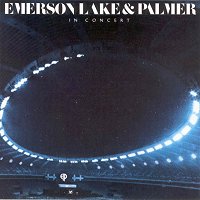 ELP had reached their creative bottom at the end of the 70's, and this yawn of a live album proved to be the last spasm before they finally disbanded. "In Concert" had been recorded already two years earlier in Canada on the "Works"-tour. We're taken through decently played but not very interesting versions of few listenable songs from the "Works"- albums ("Tiger in a Spotlight", "C'est La Vie"). They also play a version of Henry Manchini's "Peter Gunn", a theme most of you will recognise as the main-theme from the "Blues Brothers" movies. The absolutely worst moment on the album is unfortunately "Knife Edge". ELP manages to ruin this classic in an unbelievable half-assed and lame version. The orchestra only mess things up even more. Most of Side 2 is taken up by a 15-minute version of "Pictures at an Exhibition". I guess I don't have to tell you that this version is absolutely NOTHING compared to the full-length version from 1971. This version is sloppy and lame with a very weird, thin and light bass-sound from Lake. A forgettable and uninteresting album unless you're an ELP-fanatic. ELP had reached their creative bottom at the end of the 70's, and this yawn of a live album proved to be the last spasm before they finally disbanded. "In Concert" had been recorded already two years earlier in Canada on the "Works"-tour. We're taken through decently played but not very interesting versions of few listenable songs from the "Works"- albums ("Tiger in a Spotlight", "C'est La Vie"). They also play a version of Henry Manchini's "Peter Gunn", a theme most of you will recognise as the main-theme from the "Blues Brothers" movies. The absolutely worst moment on the album is unfortunately "Knife Edge". ELP manages to ruin this classic in an unbelievable half-assed and lame version. The orchestra only mess things up even more. Most of Side 2 is taken up by a 15-minute version of "Pictures at an Exhibition". I guess I don't have to tell you that this version is absolutely NOTHING compared to the full-length version from 1971. This version is sloppy and lame with a very weird, thin and light bass-sound from Lake. A forgettable and uninteresting album unless you're an ELP-fanatic.
England - "Garden Shed" (Arista 1977)
 This was not very surprisingly an English band that released their first and only album in 1977. "Garden Shed" is often regarded as an obscure classic of British progressive rock, and is easy to see why, as it's a very competent, professional, well-produced, impressively performed and complex album of British symphonic progressive rock at its most typical. Their main influence was with no doubt Yes, but you can also hear references to Genesis and Fruupp here. The opening track "Midnight Madness" is a catchy, "Roundabout"-styled song with lots of powerful mellotron and instrumental breaks. The short piano-ballad "All Alone" is the introduction to the highlight of the album: the 14-minute "Three Piece Suite". This is a great composition that more or less encapsulates everything with British progressive rock. The melodies and themes are great all the way through, and you'll get lots of tasty organ and mellotron. The drummer is an impressive Bill Bruford-clone, and you'll notice him all the time with all of his unexpected rhythmic twists and breaks. "Paraffinalea" is a shorter and very cheerful song that yet brings Yes to mind. "Yellow" is a much more mellow and acoustic track with some atmospheric Steve Howe-like guitar-work. The album closes with the monumental 15-minute "Poisoned Youth" that stands as the most complex and least accessible moment on the album. You had to have balls to release music like this in 1977, but England did it and they did it very well too. This was not very surprisingly an English band that released their first and only album in 1977. "Garden Shed" is often regarded as an obscure classic of British progressive rock, and is easy to see why, as it's a very competent, professional, well-produced, impressively performed and complex album of British symphonic progressive rock at its most typical. Their main influence was with no doubt Yes, but you can also hear references to Genesis and Fruupp here. The opening track "Midnight Madness" is a catchy, "Roundabout"-styled song with lots of powerful mellotron and instrumental breaks. The short piano-ballad "All Alone" is the introduction to the highlight of the album: the 14-minute "Three Piece Suite". This is a great composition that more or less encapsulates everything with British progressive rock. The melodies and themes are great all the way through, and you'll get lots of tasty organ and mellotron. The drummer is an impressive Bill Bruford-clone, and you'll notice him all the time with all of his unexpected rhythmic twists and breaks. "Paraffinalea" is a shorter and very cheerful song that yet brings Yes to mind. "Yellow" is a much more mellow and acoustic track with some atmospheric Steve Howe-like guitar-work. The album closes with the monumental 15-minute "Poisoned Youth" that stands as the most complex and least accessible moment on the album. You had to have balls to release music like this in 1977, but England did it and they did it very well too.
The Enid - "In the Region of the Summer Stars" (EMI 1976)
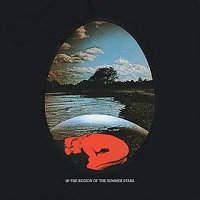 The Enid was formed by keyboard-player Robert John Godfrey (the man responsible for the orchestra-arrangements on the earliest Barclay James Harvest albums) in 1973. Although they easily were the best British progressive rock band to make a debut-album in the second half of the 70's, they were shamefully overlooked. They played a completely unique kind of instrumental symphonic progressive rock that sounded like no other band. Their sound was dominated a lot by Godfrey's very distinctive, grandiose and orchestral keyboard-arrangements. "In the Region of the Summer Stars" is for my money one of the 10 best progressive rock debuts of all time. It has a wonderful, warm and romantic atmosphere and every theme and melody is a little masterpiece in itself. The album opens with the gentle piano-tones of "The Fool" that very quickly leads into the powerful and complex "The Falling Tower". Heavy organ-riffs and dramatic guitar-themes gets relieved by quieter and more atmospheric parts where the complex themes and melodies often are the same ones as in the heavier parts, but it takes a while before you'll actually notice that. I don't think the album could have been opened in a better or more contrast full way. "Death, the Reaper" is a mellower piece, based in a very beautiful melody. One of the themes in the mid-part would later be used in the legendary "Fand" from their next album. "The Lovers" shows the band from their most symphonic, romantic and sweetest mood. The contrast is quite big to the quirky and energetic "The Devil". Side 2 opens with the simple but still very majestic theme "The Sun" that would be re-visited several times on the rest of the album. "The Last Judgement" is based on "Dies Irae" and builds gradually up into a very grandiose and symphonic part complete with choir and mellotron when the theme from "The Sun" re-appears. A short interlude played on trumpet leads into the title-track that combines a medieval-sounding melody with a strong guitar-theme, before the whole album ends with the return of "The Sun" yet again, stuffed with mellotron and grandiose organs. Pure magic. The Enid was formed by keyboard-player Robert John Godfrey (the man responsible for the orchestra-arrangements on the earliest Barclay James Harvest albums) in 1973. Although they easily were the best British progressive rock band to make a debut-album in the second half of the 70's, they were shamefully overlooked. They played a completely unique kind of instrumental symphonic progressive rock that sounded like no other band. Their sound was dominated a lot by Godfrey's very distinctive, grandiose and orchestral keyboard-arrangements. "In the Region of the Summer Stars" is for my money one of the 10 best progressive rock debuts of all time. It has a wonderful, warm and romantic atmosphere and every theme and melody is a little masterpiece in itself. The album opens with the gentle piano-tones of "The Fool" that very quickly leads into the powerful and complex "The Falling Tower". Heavy organ-riffs and dramatic guitar-themes gets relieved by quieter and more atmospheric parts where the complex themes and melodies often are the same ones as in the heavier parts, but it takes a while before you'll actually notice that. I don't think the album could have been opened in a better or more contrast full way. "Death, the Reaper" is a mellower piece, based in a very beautiful melody. One of the themes in the mid-part would later be used in the legendary "Fand" from their next album. "The Lovers" shows the band from their most symphonic, romantic and sweetest mood. The contrast is quite big to the quirky and energetic "The Devil". Side 2 opens with the simple but still very majestic theme "The Sun" that would be re-visited several times on the rest of the album. "The Last Judgement" is based on "Dies Irae" and builds gradually up into a very grandiose and symphonic part complete with choir and mellotron when the theme from "The Sun" re-appears. A short interlude played on trumpet leads into the title-track that combines a medieval-sounding melody with a strong guitar-theme, before the whole album ends with the return of "The Sun" yet again, stuffed with mellotron and grandiose organs. Pure magic.
The Enid - "Aerie Faerie Nonsense" (EMI 1977)
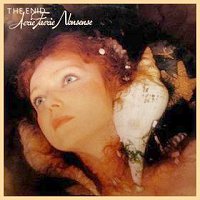 The Enid followed up their incredible debut with yet another classic. "Aerie Faerie Nonsense" was like "In the Region of the Summer Stars" obviously a concept-album, and told in music the dramatic story of a knight named Roland. The album opens with a short prelude before we're taken into a great track called "Mayday Galliard". A sweet and romantic composition in the typical Enid-vein, and the main melody sounds like it could have been from the soundtrack of a classic Hollywood-movie from the 50's. And here you can hear another good thing about The Enid: they knew exactly how many times they should play each theme without bore the listener. So instead of getting tired of the themes after you've listened to the track, you want to hear them again. "Ondine" is a mellow and beautiful tune and a kind of a mix of baroque and medieval influences. "Childe Roland" is based in a powerful guitar-theme that gets relieved by the typical and symphonic keyboard-parts of Godfrey. But the main track is of course the 17-minute "Fand" that takes up the whole of the second side. This fantastic suite is maybe one of the most perfect compositions written by anyone. The themes and melodies are extremely strong, beautiful and romantic. And the build-up of the whole track is pure genius. Some parts are a little bit sinister and dark, but it all ends in the typical romantic and beautiful Enid-style. I would bet that if The Enid had recorded and released this stuff in 1972, then they would have been just as big as Yes, Genesis and Emerson, Lake and Palmer. The Enid followed up their incredible debut with yet another classic. "Aerie Faerie Nonsense" was like "In the Region of the Summer Stars" obviously a concept-album, and told in music the dramatic story of a knight named Roland. The album opens with a short prelude before we're taken into a great track called "Mayday Galliard". A sweet and romantic composition in the typical Enid-vein, and the main melody sounds like it could have been from the soundtrack of a classic Hollywood-movie from the 50's. And here you can hear another good thing about The Enid: they knew exactly how many times they should play each theme without bore the listener. So instead of getting tired of the themes after you've listened to the track, you want to hear them again. "Ondine" is a mellow and beautiful tune and a kind of a mix of baroque and medieval influences. "Childe Roland" is based in a powerful guitar-theme that gets relieved by the typical and symphonic keyboard-parts of Godfrey. But the main track is of course the 17-minute "Fand" that takes up the whole of the second side. This fantastic suite is maybe one of the most perfect compositions written by anyone. The themes and melodies are extremely strong, beautiful and romantic. And the build-up of the whole track is pure genius. Some parts are a little bit sinister and dark, but it all ends in the typical romantic and beautiful Enid-style. I would bet that if The Enid had recorded and released this stuff in 1972, then they would have been just as big as Yes, Genesis and Emerson, Lake and Palmer.
Epidaurus - "Earthly Paradise" (Epidaurus Music 1977)
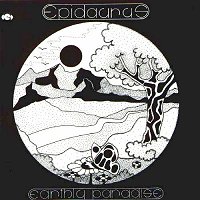 A very good album from the German symphonic progressive rock scene. Epidaurus used tons of various keyboards (including mellotron, organ, moog, piano and various electronics) to create beautiful symphonic progressive rock in the Genesis-vein, but the managed to avoid to be a clone. Two of the five tracks have some rather poor female vocals, but the rest of the tracks are instrumental. My favourite track is "Silas Marner". Very atmospheric instrumental parts with lots of mellotron and the vocal-melodies are good. But I wish they could have got another lady to sing it, as her strained and thin voice is really annoying, and it's even impossible to hear what she's singing. The two last tracks on the album is a little bit different from the rest. "Andas" is very energetic with some jazz-tendencies, while "Mitternachtstraum" is an excellent example of electronic and very German sounding progressive rock. This stuff should fit the taste of most symphonic progressive rock fans. A very good album from the German symphonic progressive rock scene. Epidaurus used tons of various keyboards (including mellotron, organ, moog, piano and various electronics) to create beautiful symphonic progressive rock in the Genesis-vein, but the managed to avoid to be a clone. Two of the five tracks have some rather poor female vocals, but the rest of the tracks are instrumental. My favourite track is "Silas Marner". Very atmospheric instrumental parts with lots of mellotron and the vocal-melodies are good. But I wish they could have got another lady to sing it, as her strained and thin voice is really annoying, and it's even impossible to hear what she's singing. The two last tracks on the album is a little bit different from the rest. "Andas" is very energetic with some jazz-tendencies, while "Mitternachtstraum" is an excellent example of electronic and very German sounding progressive rock. This stuff should fit the taste of most symphonic progressive rock fans.
Errata Corrige - "Siegfried, Il Drago E Altre Storie" (EC 1976)
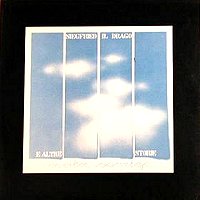 This Italian 4-piece released their first and only album in 1976. Their music was Italian symphonic progressive rock of the soft and light kind. The band used lots of flute, acoustic guitar, synths, cello and pleasant vocal-harmonies to good effect. The title-track is a suite in several parts that quite well shows all the sides of their sound and style. You'll especially notice the beautiful vocal-harmonies and the atmospheric use of the flute and synths. The melodies and songwriting is good, and the tracks also have a pleasant degree of complexity. The album was obviously a concept-album where the lyrics dealt with medieval-themes like dragons and knights. The only bad thing about the record is the very modest length of it (about only 29 minutes). But it will still be a worthy addition to your collection if you're a fan of Italian symphonic progressive rock. This Italian 4-piece released their first and only album in 1976. Their music was Italian symphonic progressive rock of the soft and light kind. The band used lots of flute, acoustic guitar, synths, cello and pleasant vocal-harmonies to good effect. The title-track is a suite in several parts that quite well shows all the sides of their sound and style. You'll especially notice the beautiful vocal-harmonies and the atmospheric use of the flute and synths. The melodies and songwriting is good, and the tracks also have a pleasant degree of complexity. The album was obviously a concept-album where the lyrics dealt with medieval-themes like dragons and knights. The only bad thing about the record is the very modest length of it (about only 29 minutes). But it will still be a worthy addition to your collection if you're a fan of Italian symphonic progressive rock.
Et Cetera - "Et Cetera" (Apostrophe 1976)
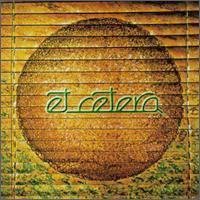 Many would say it's a lack of ambition when a band are so strongly influenced by another band that they end up sounding like a clone. However, it's something different when the band you're trying to clone is none other than Gentle Giant, as you GOT to be really good and talented to pull that off successfully. But that's just what Et Cetera from Québec did on their first and only album. And it wouldn't be fair to describe them as a complete Gentle Giant clone either, as there were several aspects about them that set them apart from their British heroes. First of all, the band had a female singer in Marie Bernard Pagé who also contributed with keyboards. Actually, Dorothea Raukes from Streemark is the only other female keyboardist in a 70's progressive rock band that I'm aware of. Pagé also shared her vocal duties with other members in the band, and this combination of female and male vocals was another thing that after all made them more than just a Gentle Giant clone. The compositions on the record are, as you surely could expect with such influences, very complex and demanding with lots of unusual time signatures and chord changes. All of them were written by multi-instrumentalist Denis Chartrand and guitarist Robert Marchand. The medieval influences are here also, especially in the beautiful "L'Age Dort". Another favourite of mine is "Entre Chien et Loup" where the vocal melodies clearly and successfully mimic Kerry Minnear's style, but with different voices. "Et La Musique Tourne" is one of the more immediate songs on the album, with melodies that alternates between upbeat and happy to more mellow and with super-tight instrumental parts. The probably heaviest song is "Éclaircie" where the band use one of Gentle Giant's tricks by playing the same themes and melodies in arrangements so different that it will take some time and many listens before it actually dawns on you. The instrumental number "Apostrophe" is a good showcase for all members in the band, especially Pagé's keyboard sound created by an instrument with the weird name of Ondes Martenot! "Tandem" has a quite unusual and unexpected ending, as the track is cut off very suddenly when it sounds like it's building up to a finale. "Et Cetera" is a must-have for fans of Gentle Giant. Many would say it's a lack of ambition when a band are so strongly influenced by another band that they end up sounding like a clone. However, it's something different when the band you're trying to clone is none other than Gentle Giant, as you GOT to be really good and talented to pull that off successfully. But that's just what Et Cetera from Québec did on their first and only album. And it wouldn't be fair to describe them as a complete Gentle Giant clone either, as there were several aspects about them that set them apart from their British heroes. First of all, the band had a female singer in Marie Bernard Pagé who also contributed with keyboards. Actually, Dorothea Raukes from Streemark is the only other female keyboardist in a 70's progressive rock band that I'm aware of. Pagé also shared her vocal duties with other members in the band, and this combination of female and male vocals was another thing that after all made them more than just a Gentle Giant clone. The compositions on the record are, as you surely could expect with such influences, very complex and demanding with lots of unusual time signatures and chord changes. All of them were written by multi-instrumentalist Denis Chartrand and guitarist Robert Marchand. The medieval influences are here also, especially in the beautiful "L'Age Dort". Another favourite of mine is "Entre Chien et Loup" where the vocal melodies clearly and successfully mimic Kerry Minnear's style, but with different voices. "Et La Musique Tourne" is one of the more immediate songs on the album, with melodies that alternates between upbeat and happy to more mellow and with super-tight instrumental parts. The probably heaviest song is "Éclaircie" where the band use one of Gentle Giant's tricks by playing the same themes and melodies in arrangements so different that it will take some time and many listens before it actually dawns on you. The instrumental number "Apostrophe" is a good showcase for all members in the band, especially Pagé's keyboard sound created by an instrument with the weird name of Ondes Martenot! "Tandem" has a quite unusual and unexpected ending, as the track is cut off very suddenly when it sounds like it's building up to a finale. "Et Cetera" is a must-have for fans of Gentle Giant.
Label
Ethos - "(Ardour)" (Capitol 1976)
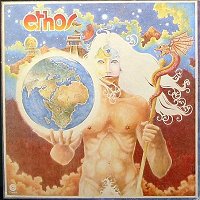 The majority of American '70s symphonic progressive rock bands were highly derivative of the most famous British ones, and the same goes definitively for Ethos who based their music strongly in that familiar Yes/Genesis/King Crimson vein. But just as their countrymen Starcastle, Ethos benefited from a strong understanding of what classic symphonic progressive rock should sound and be, as well as outstanding musicianship and complex material. The band even had two keyboardists, but guitarist Wil Sharpe seemed in many ways to be the leader of the band. The cosmic-divine homoeroticism (!) on the striking cover of their debut "(Ardour)" (I'm not sure if that's the actual name of the album or an additional name of the band) seems very promising. And sure enough, the musical content shows off their influences from the very start with the first chords of "Intrepid Traveller" based around the almost exact same chords and rhythm as Yes' "Astral Traveller". Considering the title of the track, I think (and hope) that it's meant to be intentional. A cool synth-solo appears before the track is carried on the "Astral Traveller" vibe a minute more, but all similarities quickly disappear when it all calms down to a complex and more laidback part with many fine melodies wrapped in Mellotron and many other of our favourite vintage keyboards. The various sounds of the Mellotron are used widely, including strings, choir and flute, but not all that much of the overlooked and superb brass-sound that the Mellotron also offered. The anthemic "Space Brothers" opens with some Mellotron-choir chords that float in and out through the entire song. The track is musically much simpler than the previous, despite an instrumental section toward the end. The complexity returns to the full again in "Everyman" that also has a quite involving story in the lyrics. But the perhaps definitive song of the album reveals itself in the mighty and perfect "Atlanteans". It opens with the roar of the ocean, before going into a gentle and beautiful melody that glides away on top of the Mellotron. The interplay between the two keyboardists (Michael Ponczek and Duncan Hammond) on the instrumental passages of this song reminds me occasionally of Dave Greenslade and Dave Lawson's playing in Greenslade. The band gets slightly ballsier and heavier on "The Spirit of Music" that features some truly quirky synth-solos. "Long Dancer" is a song so catchy and immediate that it would have been the band's hit song if they ever would have any. The lyrics also have some simple but pretty poetry: "In the night she lays with the sun, in the day she sleeps with the moon". "The Dimension Man" is a showcase of complex symphonic progressive rock power, and drummer Mark Richards even throws in some tricks learned from Bill Bruford in the intense instrumental part. The album closes on a more modest note with the acoustic "E'Mocean" where the keyboards again add the symphonic flair, while the sounds of the ocean in the background give a nice atmospheric effect. Unless you want absolutely every band you listen to to be unique and completely underivative of anything else, then "(Ardour)" should be pretty much impossible to dislike. Ethos were simply one of the most solid and competent bands of this style in America. The majority of American '70s symphonic progressive rock bands were highly derivative of the most famous British ones, and the same goes definitively for Ethos who based their music strongly in that familiar Yes/Genesis/King Crimson vein. But just as their countrymen Starcastle, Ethos benefited from a strong understanding of what classic symphonic progressive rock should sound and be, as well as outstanding musicianship and complex material. The band even had two keyboardists, but guitarist Wil Sharpe seemed in many ways to be the leader of the band. The cosmic-divine homoeroticism (!) on the striking cover of their debut "(Ardour)" (I'm not sure if that's the actual name of the album or an additional name of the band) seems very promising. And sure enough, the musical content shows off their influences from the very start with the first chords of "Intrepid Traveller" based around the almost exact same chords and rhythm as Yes' "Astral Traveller". Considering the title of the track, I think (and hope) that it's meant to be intentional. A cool synth-solo appears before the track is carried on the "Astral Traveller" vibe a minute more, but all similarities quickly disappear when it all calms down to a complex and more laidback part with many fine melodies wrapped in Mellotron and many other of our favourite vintage keyboards. The various sounds of the Mellotron are used widely, including strings, choir and flute, but not all that much of the overlooked and superb brass-sound that the Mellotron also offered. The anthemic "Space Brothers" opens with some Mellotron-choir chords that float in and out through the entire song. The track is musically much simpler than the previous, despite an instrumental section toward the end. The complexity returns to the full again in "Everyman" that also has a quite involving story in the lyrics. But the perhaps definitive song of the album reveals itself in the mighty and perfect "Atlanteans". It opens with the roar of the ocean, before going into a gentle and beautiful melody that glides away on top of the Mellotron. The interplay between the two keyboardists (Michael Ponczek and Duncan Hammond) on the instrumental passages of this song reminds me occasionally of Dave Greenslade and Dave Lawson's playing in Greenslade. The band gets slightly ballsier and heavier on "The Spirit of Music" that features some truly quirky synth-solos. "Long Dancer" is a song so catchy and immediate that it would have been the band's hit song if they ever would have any. The lyrics also have some simple but pretty poetry: "In the night she lays with the sun, in the day she sleeps with the moon". "The Dimension Man" is a showcase of complex symphonic progressive rock power, and drummer Mark Richards even throws in some tricks learned from Bill Bruford in the intense instrumental part. The album closes on a more modest note with the acoustic "E'Mocean" where the keyboards again add the symphonic flair, while the sounds of the ocean in the background give a nice atmospheric effect. Unless you want absolutely every band you listen to to be unique and completely underivative of anything else, then "(Ardour)" should be pretty much impossible to dislike. Ethos were simply one of the most solid and competent bands of this style in America.
Ethos - "Open Up" (Capitol 1977)
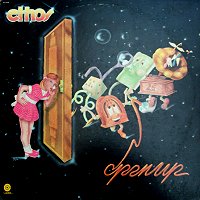 Duncan Hammond left Ethos after their artistically successful debut, but the fact that the band now had just one keyboardist didn't seem to affect the quality of their output at all. "Open Up" is every inch as good as the first album, although not as immediately accessible. But any experienced progressive rock listener will know that's just a good sign. The material is even a tad more complex than on the debut. With the exception of the very short instrumental "U.V. Melody" and the ballad "Sedona" (featuring some really tasty Steve Howe-like classical guitar on the intro and end by Sharpe), every song on "Open Up" is just as complex and technically demanding as on the best international acts. "Pimp City" opens the album as a powerful and dynamic King Crimson-ish track, but has also room for some lush and more symphonic melodies in the middle. "Start Anew" is not exactly anything less dynamic and impressive, alternating between some fast and technically superb instrumental riffs (you'll especially notice bassist Brad Stephenson here) and some more sweeping and atmospheric vocal melodies. The lengthy instrumental sections of "Memories" are sprinkled with bubbling electronic sounds, giving it a somewhat spacey feel. "The Players (of the Game)" is definitively one of the highlights on the album, being complex mid-'70s symphonic progressive rock of the quirkiest and highest calibre, featuring a fantastic and somewhat unusual Mellotron-melody in the middle that returns toward the end, but then with vocals. The slightly less impressive "Marathon II" has the same degree of complexity, and features a melody very reminiscent of one from Premiata Forneria Marconi’s “Is My Face on Straight?”. I'll also have to give credit to the band for taking geographical inspiration from their own country in the earlier mentioned "Sedona". The final track "Close Your Eyes" has a spacey feel on the vocal parts, but builds up to a more traditional symphonic progressive rock finale. Not very original perhaps, but damned mighty and powerful! "(Ardour)" and "Open Up" are among the best American symphonic progressive rock albums released, and that should be a pretty good reason for you to get both of them. They turned out to be Ethos' only releases, but considering what other progressive rock bands degraded into at the same time, and the changing musical climate at that time, a third album would probably not turned out to be very good. Then it's far better to remember them for two almost flawless albums. Duncan Hammond left Ethos after their artistically successful debut, but the fact that the band now had just one keyboardist didn't seem to affect the quality of their output at all. "Open Up" is every inch as good as the first album, although not as immediately accessible. But any experienced progressive rock listener will know that's just a good sign. The material is even a tad more complex than on the debut. With the exception of the very short instrumental "U.V. Melody" and the ballad "Sedona" (featuring some really tasty Steve Howe-like classical guitar on the intro and end by Sharpe), every song on "Open Up" is just as complex and technically demanding as on the best international acts. "Pimp City" opens the album as a powerful and dynamic King Crimson-ish track, but has also room for some lush and more symphonic melodies in the middle. "Start Anew" is not exactly anything less dynamic and impressive, alternating between some fast and technically superb instrumental riffs (you'll especially notice bassist Brad Stephenson here) and some more sweeping and atmospheric vocal melodies. The lengthy instrumental sections of "Memories" are sprinkled with bubbling electronic sounds, giving it a somewhat spacey feel. "The Players (of the Game)" is definitively one of the highlights on the album, being complex mid-'70s symphonic progressive rock of the quirkiest and highest calibre, featuring a fantastic and somewhat unusual Mellotron-melody in the middle that returns toward the end, but then with vocals. The slightly less impressive "Marathon II" has the same degree of complexity, and features a melody very reminiscent of one from Premiata Forneria Marconi’s “Is My Face on Straight?”. I'll also have to give credit to the band for taking geographical inspiration from their own country in the earlier mentioned "Sedona". The final track "Close Your Eyes" has a spacey feel on the vocal parts, but builds up to a more traditional symphonic progressive rock finale. Not very original perhaps, but damned mighty and powerful! "(Ardour)" and "Open Up" are among the best American symphonic progressive rock albums released, and that should be a pretty good reason for you to get both of them. They turned out to be Ethos' only releases, but considering what other progressive rock bands degraded into at the same time, and the changing musical climate at that time, a third album would probably not turned out to be very good. Then it's far better to remember them for two almost flawless albums.

|